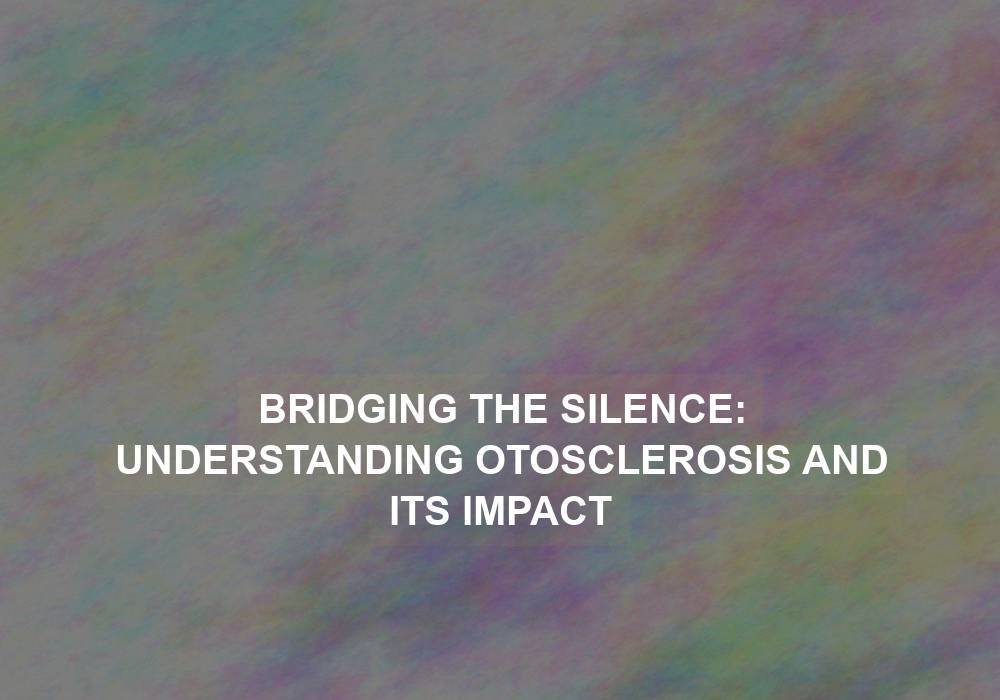Otosclerosis is a common condition that affects the bones in the middle ear, leading to hearing loss. This article aims to provide a comprehensive understanding of otosclerosis, including its causes, symptoms, diagnosis, and treatment options. By shedding light on this often misunderstood condition, we hope to bridge the silence surrounding otosclerosis and raise awareness about its impact on individuals.
Introduction
Otosclerosis is a progressive condition characterized by the abnormal growth of bone in the middle ear. It primarily affects the tiny bone structures called ossicles, which are responsible for transmitting sound vibrations. As otosclerosis progresses, it interferes with the normal movement of these bones, resulting in hearing loss.
Otosclerosis can have a significant impact on an individual’s quality of life, affecting their ability to communicate, work, and engage in social activities. It is crucial to understand the causes, symptoms, and available treatment options to effectively manage this condition.
What is Otosclerosis?
Otosclerosis is a condition that causes the bones in the middle ear to become abnormally thickened and stiff, leading to hearing loss. The exact cause of otosclerosis remains unknown, but research suggests that it may be influenced by both genetic and environmental factors.
Studies have found a hereditary link, indicating that certain genes may predispose individuals to develop otosclerosis. Additionally, hormonal changes, such as those experienced during pregnancy, have been associated with an increased risk of developing the condition.
Causes of Otosclerosis
While the exact cause of otosclerosis is unknown, several factors may contribute to its development. Genetic predisposition plays a significant role, with certain genes potentially increasing the likelihood of developing otosclerosis.
Environmental factors, such as hormonal changes during pregnancy or exposure to certain infections, may also contribute to the development of otosclerosis. Additionally, there is evidence to suggest that individuals with a family history of otosclerosis are more likely to develop the condition.
Symptoms of Otosclerosis
The most common symptom of otosclerosis is gradual hearing loss, which typically begins in early adulthood. Individuals with otosclerosis may notice difficulty hearing low-frequency sounds, such as whispers or soft voices. As the condition progresses, hearing loss may extend to higher frequencies.
In addition to hearing loss, otosclerosis may present with other symptoms, including tinnitus (ringing or buzzing in the ear), dizziness or vertigo, and a sensation of pressure or fullness in the ear. These symptoms can significantly impact an individual’s day-to-day life and overall well-being.
Diagnosing Otosclerosis
To diagnose otosclerosis, a thorough examination of the ears and a comprehensive hearing evaluation is necessary. An otolaryngologist or an ear, nose, and throat specialist may perform various tests to assess the extent of the condition and determine the most appropriate treatment options.
Audiometry is a common test used to measure hearing sensitivity and identify the specific frequencies affected by otosclerosis. Tympanometry, which assesses the movement of the eardrum and middle ear function, can also provide valuable information about the condition. In some cases, imaging tests such as a CT scan or MRI may be conducted to visualize the middle and inner ear structures and confirm the diagnosis.
Treatment Options for Otosclerosis
While there is currently no cure for otosclerosis, several treatment options are available to manage the condition and improve hearing in affected individuals.
-
Hearing aids: In the early stages of otosclerosis, hearing aids can be beneficial in amplifying sounds and compensating for hearing loss. These devices can be customized to suit individual needs and provide significant improvement in hearing ability.
-
Stapedectomy or stapedotomy: These surgical procedures aim to replace the damaged stapes bone with a prosthetic device, allowing sound transmission to the inner ear. These procedures have shown promising results in improving hearing in individuals with otosclerosis.
-
Bone-anchored hearing aids (BAHA): BAHA is an implantable device that bypasses the damaged middle ear and directly stimulates the inner ear, thus improving hearing. This option is particularly beneficial for individuals who are not suitable candidates for traditional hearing aids or surgical procedures.
It is important to consult with a healthcare professional to determine the most appropriate treatment option based on the severity of otosclerosis and individual circumstances.
Coping with Otosclerosis
Living with otosclerosis can be challenging, especially when it comes to communication and social interactions. However, there are strategies and support systems available to help individuals cope with the condition.
-
Educate yourself: Take the time to learn more about otosclerosis and its impact on hearing. Understanding the condition can help you manage its effects better and make informed decisions about treatment options.
-
Communication strategies: Inform friends, family, and colleagues about your condition so they can provide necessary support and make accommodations for clearer communication. Utilize techniques such as facing the person you are speaking with, speaking clearly, and using visual aids if needed.
-
Assistive devices: In addition to hearing aids, consider utilizing other assistive devices, such as captioned telephones or smartphone apps that amplify sound. These devices can enhance your hearing abilities and improve your overall quality of life.
Conclusion
Otosclerosis is a condition that affects many individuals worldwide, often resulting in hearing loss and other associated symptoms. By raising awareness and understanding otosclerosis, we can bridge the silence surrounding this condition and provide support to those affected by it.
If you or someone you know is experiencing symptoms of otosclerosis, it is essential to seek medical evaluation and explore the available treatment options to manage the condition effectively. With the right support and resources, individuals with otosclerosis can lead fulfilling lives and overcome the challenges associated with this condition.
(Note: The revised blog article is presented in markdown format)
